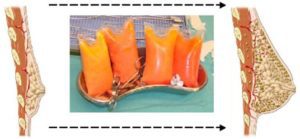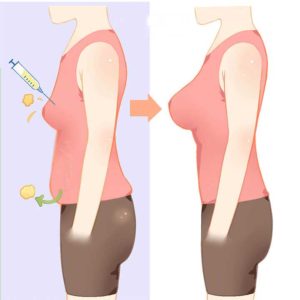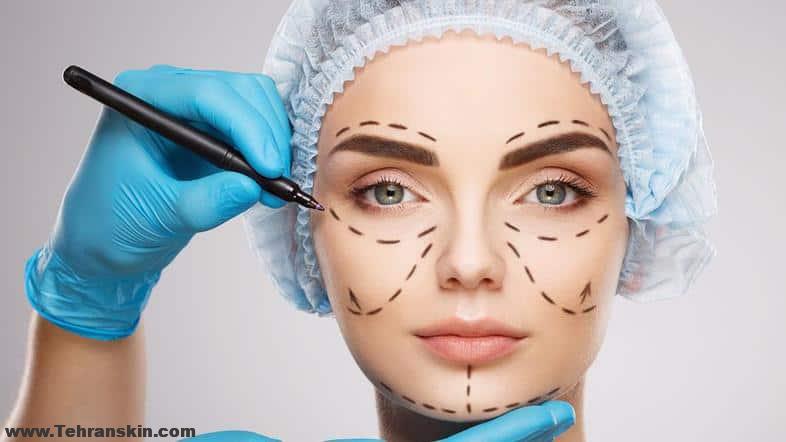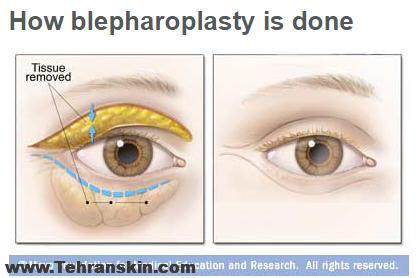
Some women like the idea of having bigger breasts, but don’t like the idea of breast implants. Breast augmentation with fat is technically known as autologous breast augmentation. This procedure uses a woman’s own fat instead of breast implants to increase the size of the breasts. The fat is liposuctioned from a body area with excess fat and then injected into the breasts for augmentation.
Fat transfer breast augmentation essentially uses liposuction to take fat from other parts of your body and inject it into your breasts. This is a breast augmentation option for women who are looking for a relatively small increase in breast size and would prefer natural results.
Significant research on fat transfer breast augmentation has been done:
- Pre-Expansion Technique Allows Successful Mega-Volume Fat Transfer to the Breasts
- Fat Transfer Provides Alternative to Breast Implants
- New Technique Doubles Breast Size Using Patient’s Own Fat
محتوای صفحه
What does the process of fat transfer breast augmentation look like?
to understand the process of fat transfer breast augmentation, click here to watch the video.
Advantages and Disadvantages of fat transfer breast augmentation

Advantages
Breast augmentation using autologous fat is a potentially great procedure. Fat is liposuctioned from areas of excess and is then injected into the breasts for augmentation. The benefit is that since a woman is using her own fat, there is no need for an implant. Also, if the fat heals well, the breasts look and feel normal. Additionally, the only incisions are the four-millimeter incisions used to harvest (liposuction) and inject the fat.
When used to augment healthy breasts, it has a good track record for few complications or needs for re-operations compared to implant-based augmentation.
Reviews of cases where it has been used for breast reconstruction have found that it has a relatively low complication rate and most women and their doctors are satisfied with the results. Studies have found it safe and not promoting cancer recurrence or complications.
in a nutshell, the advantages of fat transfer to the breast may include:
- No implant used
- Small Incisions
- Uses woman’s own excess fat
- The relatively low complication rate
- Breast look and feel natural
- Good safety record
- Patients and doctors are satisfied with the results
Disadvantages
Compared to breast augmentation with implants, there are several disadvantages to autologous breast augmentation. Although detailed descriptions of how to obtain, prepare and inject fat have been described in the plastic surgery literature, there is no standard technique for autologous breast augmentation. For this reason, it is essential that any woman seeking breast augmentation with fat is aware of the disadvantages and limitations when compared to traditional breast augmentation.
- Requires use of the BRAVA system: Fat transfer into the breast usually requires the use of the BRAVA system prior to surgery. The BRAVA is an external tissue expansion system. The system works by suction action. The suction cups are worn over the breasts for 10 to 12 hours per day for three to five weeks prior to surgery. The final week before surgery, the BRAVA must be worn non-stop (only taking it off to shower). By this time, the expansion has stretched the breast tissues and made a space into which the fat can be injected. The system also increases the blood flow to the area, increasing the likelihood of fat survival. Without pre-expansion, results are less reliable. The expansion system must also be used for three months after the surgery.
- Breast enlargement is usually limited to one cup size: While the external tissue expansion system increases blood flow to the breasts, it is not enough to instantly support a large amount of fat. Because the fat does not have its own blood supply to keep it alive, a limited amount of fat can be injected. At most, an A-cup breast will increase to a B-cup. With breast implants, there is no such limitation.
- Minimal to no breast lift: If a woman has ptotic (droopy or sagging) breasts, autologous breast augmentation will not improve the problem. She will still need a breast lift to improve the sagging.
- Unpredictable survival of the fat: Because the fat does not have its own blood supply to keep it alive, it relies on the blood supply already in the breast. Consequently, a limited amount of fat can be injected. If more fat is injected than can be supported, the fat will be reabsorbed and possibly become hardened. Additionally, fat resorption means there is no increase in breast size.
- Fat injection may interfere with breast screening examinations: The volume of fat required to enlarge the breast makes the technique prone to calcifications. These calcifications will be visible on a mammogram. These changes will be present over a woman’s lifetime. The pattern of those calcifications is different from calcifications associated with breast cancer. However, they may result in the need for more frequent breast biopsies, especially if there is a strong history of breast cancer in the family. A lifetime of close monitoring and follow-up may be necessary.
- A sufficient amount of fat is needed: In order to effectively increase breast size, sufficient body fat to harvest at least 1,000 milliliters of pure fat is needed. Lean women are not good candidates for this procedure.
- The technique requires a compliant, motivated patient: The best candidates for this procedure are self-motivated women, as the external expansion process is self-directed after an initial consultation with the surgeon. Additionally, the expansion device has to be worn over the breasts for ten to twelve hours per day for three to five weeks prior to surgery.
Initially, the American Society of Plastic Surgeons (ASPS) did not recommend the use of fat grafting for breast augmentation. In 1987, the ASPS indicated that because of the side effects (i.e., dense lumps, oil cysts, and calcifications), autologous fat grafting to the breast might compromise breast cancer surveillance and should, therefore, be prohibited. Most plastic surgeons stopped performing the procedure.
What are the risks of fat transfer breast augmentation?

Fat transfer breast augmentation risks include:
- Cysts
- Infection
- Microcalcification
- Necrosis (death) of fat cells
- The possibility that some of the transferred fat cells will leave the breast area
Your plastic surgeon may also have you use a tissue expansion system during the weeks before your breast augmentation surgery to improve your results. You may have to have touch-up injections to retain your improved shape if you choose this surgery.
How do I choose a plastic surgeon for fat transfer breast augmentation?

Breast augmentation involves many choices. The first and most important is selecting a board-certified plastic surgeon you can trust.
A board-certified plastic surgeon meets rigorous standards:
- Board certification
- Complete at least six years of surgical training following medical school with a minimum of three years of plastic surgery residency training
- Pass comprehensive oral and written exams
- Graduate from an accredited medical school
- Complete continuing medical education, including patient safety, each year
- Perform surgery in accredited, state-licensed, or Medicare-certified surgical facilities
By choosing a board-certified plastic surgeon, you can be assured that you are choosing a qualified, highly-trained plastic surgeon who is board-certified.
In short, before considering this technique for augmentation, a woman needs to consider not only the enhancement expected but also possible long-term effects associated with the fat transfer to the breast.
Our surgeon is well-named and well-experienced at fat transfer breast augmentation. You can contact us to consult and set an appointment (please click here).



